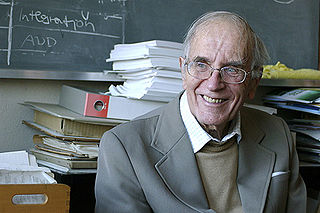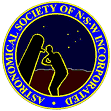Near-Earth Asteroid Tracking (NEAT) was a program run by NASA and the Jet Propulsion Laboratory, surveying the sky for near-Earth objects. NEAT was conducted from December 1995 until April 2007, at GEODSS on Hawaii, as well as at Palomar Observatory in California. With the discovery of more than 40 thousand minor planets, NEAT has been one of the most successful programs in this field, comparable to the Catalina Sky Survey, LONEOS and Mount Lemmon Survey.

Paul Wild was a Swiss astronomer and director of the Astronomical Institute of the University of Bern, who discovered numerous comets, asteroids and supernovae.

The Spacewatch project is an astronomical survey that specializes in the study of minor planets, including various types of asteroids and comets at Kitt Peak National Observatory near Tucson, Arizona, in the United States.

Catalina Sky Survey is an astronomical survey to discover comets and asteroids. It is conducted at the Steward Observatory's Catalina Station, located near Tucson, Arizona, in the United States.

Henry Lee Giclas was an American astronomer and a discoverer of minor planets and comets.
Hendrik van Gent was a Dutch astronomer.
Roy A. Tucker (born 1951 in Jackson, Mississippi) is an American astronomer best known for the co-discovery of near-Earth asteroid 99942 Apophis (formerly known as 2004 MN4) along with David J. Tholen and Fabrizio Bernardi of the University of Hawaii. He is a prolific discoverer of minor planets, credited by the Minor Planet Center with the discovery of 702 numbered minor planets between 1996 and 2010. He has also discovered two comets: 328P/LONEOS–Tucker and C/2004 Q1, a Jupiter-family and near-parabolic comet, respectively.
Alfred Schmitt was a French astronomer. Schmitt worked at Algiers Observatory in the 1930s and 1940s and at the Royal Observatory in Uccle, Belgium in the 1950s. From 1955 to 1958 he was also director of the Quito Observatory in Ecuador. He extensively studied minor planets and comets and is credited with having discovered four asteroids.
Jeffrey S. Medkeff, usually known as Jeff Medkeff, was a prominent science writer and educator. He was also a designer of robotic telescopes, a minor philanthropist, and an advocate of personal and sexual freedom.
Stephen J. Edberg is a scientist at the Jet Propulsion Laboratory. He is perhaps best known for creating collaborative efforts between amateur and professional astronomers. A professional astronomer since 1970, Edberg still considers himself to be an active amateur astronomer as well and is an active astronomical observer, photographer, and telescope maker. He presently serves as staff astronomer for the Solar System Exploration website posted by NASA Headquarters and staff scientist for Earth science communication and for Exoplanet Exploration communication.
11132 Horne, provisional designation 1996 WU, is a Hygiean asteroid from the outer regions of the asteroid belt, approximately 13 kilometers in diameter. It was discovered on 17 November 1996, by American amateur astronomer Dennis di Cicco at his Sudbury Observatory in Massachusetts, United States. The asteroid was named for Johnny Horne, photo editor of The Fayetteville Observer.
(450894) 2008 BT18 is a sub-kilometer asteroid and synchronous binary system, classified as near-Earth object and potentially hazardous asteroid of the Apollo group. It was discovered on 31 January 2008, by the LINEAR program at Lincoln Laboratory's Experimental Test Site near Socorro, New Mexico, United States. The eccentric asteroid measures approximately 600 meters in diameter and has a composition of a basaltic achondrite.

Table Mountain Observatory (TMO) is an astronomical observation facility operated by NASA's Jet Propulsion Laboratory. It is located in Big Pines, California, in Angeles National Forest near Wrightwood, north-northeast of Los Angeles, California, in the United States.
Richard A. Kowalski is an American astronomer who has discovered numerous asteroids and comets, among them, many near-Earth objects.
(5496) 1973 NA, is a very eccentric and heavily tilted asteroid, classified as near-Earth object of the Apollo group, approximately 2 kilometers in diameter. It was discovered on 4 July 1973, by American astronomer Eleanor Helin at the U.S. Palomar Observatory in California. At the time of its discovery, it was the most highly inclined minor planet known to exist. It may be the parent body of the Quadrantids.
Fabrizio Bernardi is an Italian astronomer and discoverer of minor planets and comets, best known for the co-discovery of the near-Earth and potentially hazardous asteroid 99942 Apophis.

2010 JL88 is an unnumbered asteroid, classified as a near-Earth object of the Apollo group, approximately 19 meters in diameter. It was first observed by the Siding Spring Survey, Australia, on 15 May 2010. It is known to be the fastest rotator with an unambiguous period solution, having an exceptionally rapid rotation period of less than 25 seconds.

The Astronomical Society of New South Wales (ASNSW) is an amateur astronomy club in the state of New South Wales, Australia. It was founded in 1954 and it has over 400 members.
Kazimieras Černis is a Lithuanian astronomer and astrophysicist, active member of the IAU, and a prolific discoverer of minor planets and comets. In 2012, he discovered 420356 Praamzius, a trans-Neptunian object and dwarf planet candidate.

2016 AJ193, also known as 2010 KV134, is a near-Earth object and potentially hazardous asteroid of the Apollo group, approximately 1.4 kilometres (0.87 mi) in diameter. It was discovered on 17 May 2010 by the Wide-field Infrared Survey Explorer (WISE) satellite, but was lost until it was reobserved on 16 January 2016. With an observation arc over 11 years, 2016 AJ193 has a well-determined orbit and trajectory through the year 2086. The asteroid's orbit is only potentially hazardous on a time scale of thousands of years.








